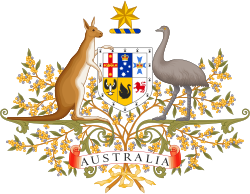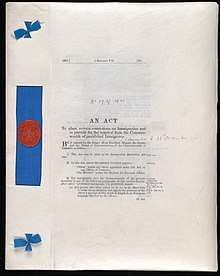Immigration Restriction Act 1901
The Immigration Restriction Act 1901[2] was an Act of the Parliament of Australia which limited immigration to Australia and formed the basis of the White Australia policy which sought to exclude all non-Europeans from Australia. The law granted immigration officers a wide degree of discretion to prevent individuals from entering Australia. The Act prohibited various classes of people from immigrating and provided for illegal immigrants to be deported.[3]
| Immigration Restriction Act 1901 | |
|---|---|
 | |
| Parliament of Australia | |
Long title
| |
| Royal assent | 23 December 1901 |
| Repealed | 1 June 1959 |
| Introduced by | Edmund Barton (5 June 1901) |
| Repeals | |
| Migration Act 1958[1] | |
| Amended by | |
| 1905, 1908, 1910, 1912, 1920, 1924, 1925, 1930, 1932, 1933, 1935, 1940, 1948, 1949 | |
| Status: Repealed | |
Because of opposition from the British government, a more explicit racial policy was avoided in the legislation, with the control mechanism for people deemed undesirable being a dictation test, which required a person seeking entry to Australia to write out a passage of fifty words dictated to them in any European language, not necessarily English, at the discretion of an immigration officer.[4] The test was not designed to allow immigration officers to evaluate applicants on the basis of language skills, rather the language chosen was always one known beforehand that the person would fail.[5]
The initial bill was based on similar legislation in South Africa.[5]
Provisions of the Act

General
The Act specifically prohibited various classes of people from immigrating, including people with infectious diseases and people who had recently been imprisoned.[6]
The Act automatically allowed certain classes of people to enter Australia, such as all members of the British Army or the Royal Navy, the captain and crew of any ship visiting an Australian port, any person sent on the business of a foreign government, family members of permitted immigrants, and former residents of Australia.[7]
Prospective immigrants were allowed to apply for a Certificate of Exemption, issued by the Minister for External Affairs (or a representative), which would exempt a person from the provisions of the Act such as the dictation test for a specified time.
Dictation test
The Act provided that any would-be immigrant could be subjected to a 50-word dictation test:
- "Any person who when asked to do so by an officer fails to write out at dictation and sign in the presence of the officer a passage of fifty words in length in a European language directed by the officer"[6]
Such a person would be a "prohibited immigrant" and was to be prevented from landing.[8]
This was similar to tests previously used in Western Australia, New South Wales and Tasmania. It enabled immigration officials to exclude individuals on the basis of race without explicitly saying so. After 1903 the passage chosen was not important in itself as it was already decided the person could not enter Australia and so failure was inevitable. Although the test could theoretically be given to any person arriving in Australia, in practice it was given selectively on the basis of race, and others considered undesirables.[9][10] Between 1902 and 1909, 52 people passed the test out of 1,359 who were given it.[3]
Offences
The Act established a range of federal crimes relating to immigration. Illegal immigrants could be imprisoned for up to six months, and could then be deported. Both the captain and the owners of ships which transported illegal immigrants to Australia could be fined GBP 100 for each immigrant, unless the immigrant was European. The Minister for Foreign Affairs was also able to detain ships which were suspected of carrying illegal immigrants. People who brought ill or insane immigrants into Australia were also liable for the costs of caring for them, on top of other penalties.
Controversies
The dictation test came into disrepute when it began to be used to exclude and deport individuals which the government considered undesirable.
Jewish political activist Egon Kisch from Czechoslovakia, who was exiled from Germany for opposing Nazism, arrived in Australia in 1934. The Government of Joseph Lyons went to extraordinary lengths to exclude Kisch, including using the dictation test. Kisch was fluent in a number of European languages, and after completing passages in several languages, he finally failed when he was tested in Scottish Gaelic. The officer who tested him had grown up in northern Scotland, and did not have a particularly good grasp of Scottish Gaelic himself. In the High Court case of R v Wilson; ex parte Kisch the court found that Scottish Gaelic was not within the fair meaning of the Act, and overturned Kisch's convictions for being an illegal immigrant. The failure to exclude Kisch brought the dictation test into widespread public ridicule.
In 1936, the dictation test was controversially used again to exclude Mabel Freer, a white British woman born in India. She was twice set the test in Italian, which she failed.[11] In the face of a long press and legal campaign for her admission, the government was unable or unwilling to provide a convincing reason for her exclusion and eventually she was admitted, welcomed by a huge crowd at the quay in Sydney. Interior Minister Thomas Paterson resigned from the Lyons Cabinet in 1937 as a result of the controversy.
Changes to the Act
At first the dictation test had to be given in any European language and the dictation test could be administered any time within the first year of a person's arrival to Australia. In 1905 the Act was amended so that the dictation could be submitted in "any prescribed language", the restriction to European languages remaining active until such prescribed language be chosen by the Parliament.[12] This wording was used to placate the objection from Japan that only European languages could be used. As the Parliament never prescribed any language, the dictation case remained limited to European languages only—and more specifically to the main language of any European nation, as illustrated in the infamous Attempted exclusion of Egon Kisch from Australia.[13]
In 1932 the period during which the test could be given was extended to the first five years of residence and officials could give the test to an individual an unlimited number of times.
The Immigration Restriction Act was replaced by the Migration Act 1958,[1] which replaced the dictation test with a universal visa system (or entry permits), and removed many of the other restrictions, although many migrants from southern Europe and Asia were already living in Australia, some of them having arrived as refugees during or after World War II.
See also
- George Kwok Bew, an anti Act campaigner
- War-time Refugees Removal Act 1949
References
- "Migration Act 1958 (Cth)". Federal Register of Legislation.
- "Immigration Restriction Act No. 17 of 1901 (Cth)". Federal Register of Legislation.
- "Immigration Restriction Act 1901 (Cth)". Documenting a Democracy. Museum of Australian Democracy. Retrieved 7 November 2016.
- In 1905, following Japanese reclamations, the Act was amended to "any prescribed language", with European languages remaining the only one authorized pending the selection of such prescribed language by the Parliament, which was never done. A. H. Charteris, "Australian immigration laws and their working", in Norman MacKenzie (ed.), The legal status of Aliens in Pacific countries, Oxford: Oxford University Press, 1937, p. 30.
- "The Establishment of the Immigration Restriction Act". Australian Broadcasting Corporation: Australia's Centenary of Federation. Archived from the original on 12 December 2004.
- Section 3 (a) dictation test, (d) diseases & (e) imprisonment "Immigration Restriction Act No. 17 of 1901 (Cth)". Federal Register of Legislation.
- Section 3 (i) Army & Navy, (k) crew of vessel, (l) foreign government, (m) family members & (n) former residents "Immigration Restriction Act No. 17 of 1901 (Cth)". Federal Register of Legislation.
- s 14 "Immigration Restriction Act No. 17 of 1901 (Cth)". Federal Register of Legislation.
- "Australia and Refugees, 1901–2002". Parliament of Australia Library. Retrieved 7 March 2015.
- "Immigration Restriction Act 1901". Parliamentary Education Office. Archived from the original on 22 October 2005.
- Robertson, Kel; Hohmann, Jessie; Stewart, Iain (2005). "Dictating to One of 'Us': the Migration of Mrs Freer". Macquarie Law Journal. 5: 241.
- Immigration Restriction Amendment Act 1905 (NO. 17, 1905)
- A. H. Charteris, "Australian immigration laws and their working", in Norman MacKenzie (ed.), The legal status of Aliens in Pacific countries, Oxford: Oxford University Press, 1937, p. 30.
Reading
- "The Australian Dictation Test". Tenpoundpom.com. Archived from the original on 1 March 2014. Retrieved 27 April 2014. Real examples to see if you can pass the test.
- "Administering the Dictation Test, 1950s". Immigration Museum. Archived from the original on 29 August 2008. Retrieved 13 July 2005.
- "Abolition of the 'White Australia' Policy". Dept of Immigration and Citizenship. Archived from the original on 1 September 2006. Retrieved 5 January 2010.
- Robertson, Kel; Hohmann, Jessie; Stewart, Iain (2005). "Dictating to One of 'Us': the Migration of Mrs Freer". Macquarie Law Journal. 5: 241. Gives examples of the dictation test in English and Italian.